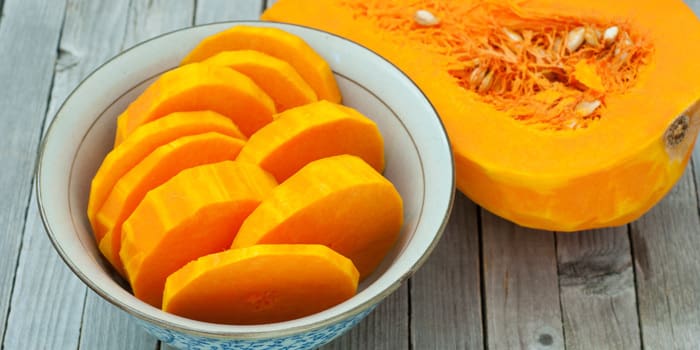How to Enjoy Winter Squash

It’s the middle of winter. What’s there to eat? Look no further than winter squash! This nutrient-packed vegetable first comes into season in the fall but you can still find them come February and they’re a healthy, hearty option when it’s freezing outside. Not sure what a winter squash is? You’ve probably carved one towards the end of October. Yes, pumpkins are just one type of winter squash variety. There are literally hundreds of winter squash varieties, but some of the more popular ones available at the market include Butternut, Kabocha, Delicata, and Hubbard.
The myriad of options and flavors available from winter squash should really be enough to get it on your home menu, but there’s also some powerful nutrition packed in these gourds. The yellow and orange color flesh is loaded with carotenoids, most notably beta-carotene. Carotenoids have strong antioxidant properties and also help cell to cell communication, which can help control cell growth. In terms of an “eat the rainbow” strategy, winter squashes are one of your best bets in the orange and yellow category. Another interesting discovery is that carotenoids increase the longer squash is stored. If stored in a cool dry place, winter squash will keep for months after harvest.
As with any food, there’s slight differences in each variety, but on the whole they all perform fairly similarly in the kitchen. Talk with your local farmer or produce specialist about the options available and experiment with different types to learn what you like best.
Where to Start
Often, your best bet is to start by carefully cutting squash in half and cleaning out the seeds (save them for roasting if you’re so inclined). This first slice creates a flat edge to lay the squash on for further breaking down. It is much easier (and safer) to work with it at this point.
The Skin
Yes, you can eat the skin of winter squash. In fact, it is very nutritious and has a high concentration of vitamins, minerals, and fiber. Skin also gets crunchy when cooked in fats through roasting or sautéing. Who doesn’t like a little crunch in their meal? Of course, there are also times when that texture is not ideal (a puree would be one example), so no harm in removing it as well. Peelers generally aren’t strong enough to remove the hard skin of winter squash, so take advantage of that good edge on your chef’s knife. Lay the halved winter squash on the flat end and cut away skin by shaving small pieces off. The going is slow the first few times, but with practice, the process is pretty efficient.
The Seeds
Cut into a winter squash and you’ll find a ton of seeds waiting on the inside. Many folks roast the seeds garnered from pumpkin carving sessions, but all winter squash seeds are edible and chalk full of nutrition. Squash seeds (often simply referred to as pumpkin seeds) are full of quality fats, protein, an assortment of minerals and some pretty powerful phytonutrients.
Roast It
Roasted squash can be added to all sorts of dishes or simply enjoyed on its own. Roasting deepens the sweet flavors and allows soft flesh to toughen up and get crunchy (just like a potato). As mentioned above, leaving the skin on creates an even more exciting texture. Be sure to roast squash in a single layer and leave a bit of space between each piece. Without enough space for hot air to flow between pieces, the squash will steam more than roast, resulting in less caramelization and texture development.
Some ideas:
– Season with salt, pepper, and fresh herbs to enjoy as a simple side
– Let pieces cool and then toss with salad greens and dressing
– Add it to stir-fries, curries, or other one-pot meals to mix things up
Puree It
Pureeing squash is an easy way to process a large amount at once, and given the size of some varieties, this can be very helpful. Most people prefer to remove the skin, but again, this is not always necessary. Steam large pieces of squash together in a stockpot. Once soft, remove from heat and mash it all together. Once you’ve got a batch of puree, the sky is really the limit.
Some ideas:
– Thin the puree with stock, season to taste, and add a touch of cream for a simple soup
– Add some butter and spices to use as a seasonally-relevant mashed potato alternative
– Mix into batters for muffins, breads, and cakes to add color, flavor, and nutrition
Shred It
Here’s something off the beaten path to experiment with. Skip cooking the squash and simply shred it raw like other root vegetables. The raw product has great texture and fresh flavor that many people quickly fall in love with. While winter squash stores quite well, this technique works a bit better with fresher product. To do so, just remove the skin from a fresh squash, halve, and shred with a box grater.
Some ideas:
– Mix with other grated root vegetables and simple vinaigrette for a winter salad
– Mix with dried fruit, nuts, and a creamy dressing for a rich winter slaw
– Use like noodles in simple pasta salad recipes for a lower carb option
Here are some squash recipes to try:
Butternut Squash Soup with Ginger
Roasted Pumpkin Salad with Lentils
Roasted Acorn Squash with Mushroom Ragu
Cauliflower Pumpkin Au Gratin
Pumpkin Bread
Apple and Butternut Squash Soup
Pumpkin Chili
